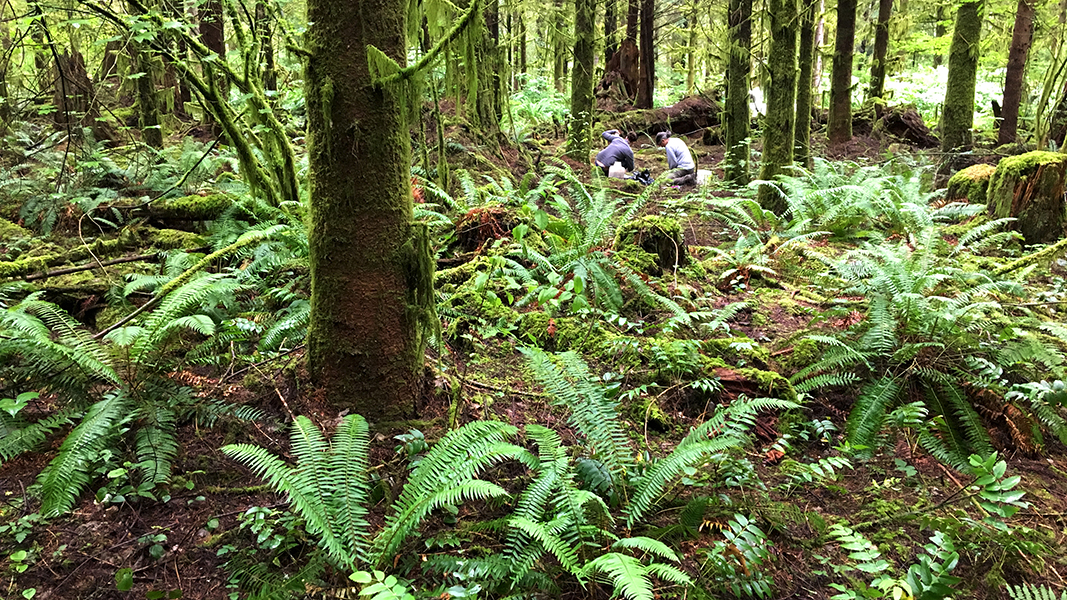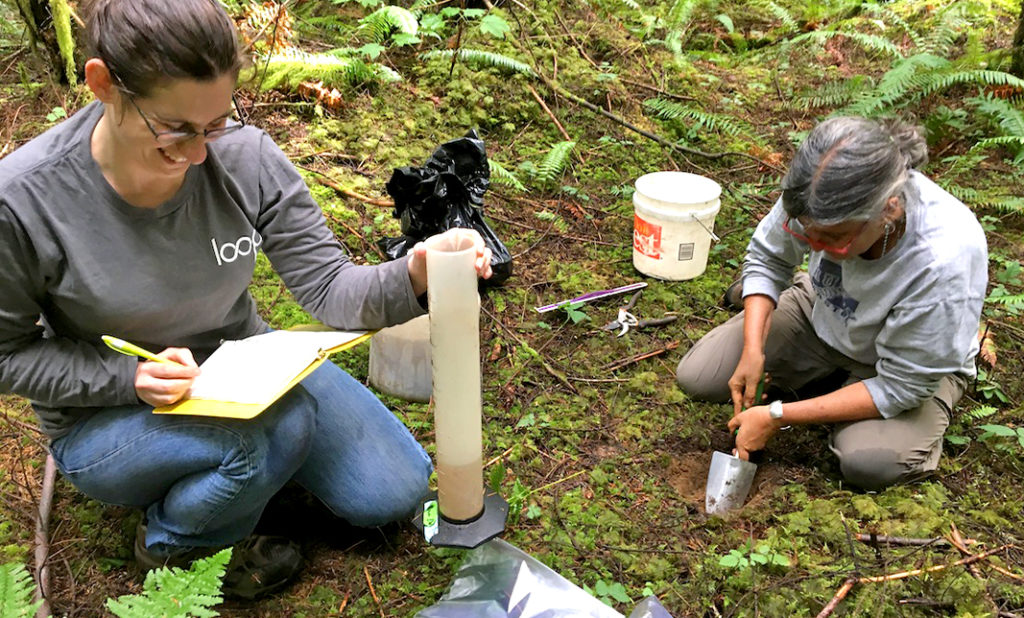Top: Forest soils that had multiple applications of municipal biosolids were evaluated for total soil carbon.
 Sally Brown
Sally Brown
To model or to measure? Not quite the existential crisis of “To be or not to be” but still a critical question. When you are adding organics to soil there is a good chance that you will increase the total soil carbon. Soil carbon storage is a good thing — that is not a question. The question arises if you want to know exactly how much your EOM (exogenous organic matter, i.e., stuff you put on the soil that you got from somewhere else) gives to the soil. To answer that you have two options: Use one of several models to get a reasonable estimate or measure yourself. Sometimes if you measure yourself, you can really hit the jackpot. Other times you risk showing little to no benefit.
I’ll give you an example. I recently sampled forest soils that have had multiple applications of municipal biosolids. We focused on two sites in close proximity to each other. Both had been planted in Douglas Fir. Both had about the same loading rate of biosolids (Leonard, et al., 2021). For one of the sites we really hit the money — the equivalent of 5 tons of CO2e (carbon dioxide equivalent) for each dry ton of biosolids. For the other, we would have been better off with the model; no evidence of carbon storage so just a small credit (0.2 tons of CO2e) for the fertilizer avoidance. I’ll get to the likely explanation for this difference in a bit. First, some basics.
Measure It Yourself

Measuring requires determining how deep you want to sample and whether you want to sample at different depths. Photos courtesy of Sally Brown.
Measuring yourself is not a simple task. Two components are involved in figuring out how much carbon is stored in the soil. One is to measure the percentage of carbon in the soil; the other is figuring out how much the soil weighs. Measuring the percent carbon is pretty straightforward. You collect a representative soil sample and send it to a lab, where it is put into a furnace. A machine measures the total C and N volatilizing off of the sample as it cooks. These correspond to the total C and N in the soil.
You have to make sure that your soil is acidic (generally pH less than 7) because otherwise a portion of the C that you measure may be carbonates (a type of rock) instead of living material. You also have to decide how deep you want to sample and whether you want to sample at different depths. For example, for the forest soil study the biosolids were surface applied. We collected the organic horizon on the soil surface (dead stems, needles and leaves) and then soils at 0-5, 5-10, 10-20 and 20-30 cm. We split the depths up to get higher resolution and increase the potential to be able to detect changes close to the surface. It worked, but it was also not the easiest thing to do.
Measuring the weight of the soil is something that you can do yourself but it is not that simple. In order to measure the weight of the soil at a particular depth, you have to collect a sample for soil bulk density. That is the weight of the soil per a fixed volume of soil. A normal soil will have a bulk density of about 1.3 g cm3. When you add compost or other organics to the soil you typically reduce the bulk density, making the soil lighter and improving soil tilth. Lower bulk density is great for the soil but not so good for storing more carbon. To end up with net carbon storage you need to hope that the bulk density stays the same or that the carbon goes up more than the bulk density goes down.
Here are some examples:
- Control Total C = 1% bulk density = 1.33 depth = 10 cm
Total C stored per 10 cm = 1 hectare of soil = 10 000 m2; 10 cm = 0.1 m
Your total soil weight is: 10 000 m2/ha * 0.1 m/cm * 1.3 g/cm = 1 330 tons ha - Of that the C weighs
1% C = 10 g C/kg soil
1% * 1330 tons soil = 13.3 tons C per ha - Now if you up that C to 2% and hold the bulk density (BD) the same you get
2% *1330 tons soil = 26.6 tons C per ha - But if you increase the C to 2% and decrease the BD to 1
2% * 1000 tons soil = 20 tons of C per ha
So still an increase but not nearly as much. The Australians have a good guide for doing this calculation.
When It Makes Sense To Model
It made sense for me to dig holes in the woods because there was a consistent and long history of biosolids use. Same biosolids applied the same way to the same soils with the same climate and same trees. We also had soils nearby with the same climate, same trees with no biosolids — in other words, a control treatment. If you want to measure yourself, you want a consistent history of compost use over an extended period with a corresponding control. The absolute best version of this is long-term studies in partnership with a university. Most people/programs don’t have that long history or that single type of application.
I recently did a carbon balance for the King County (Washington) food scraps composting program. The food scraps get composted with yard trimmings and the final product goes here, there and everywhere. Home gardeners buy it. The Washington State Department of Transportation buys it. It gets used in rain gardens and at truck farms. While you might find two users with a similar history, you don’t have that long-term consistency of use with a corresponding control that you need to do product specific measures.
Instead, I used different models. I also went to the literature and to what locally available data I could find. That data showed the net carbon storage for each ton of compost or biosolids that was applied covered a very wide range. It went from 0.08 tons of C for compost added to a healthy soil and planted in mixed shrubs to 0.47 tons for a biosolids soil blend added to a highway right of way. That gets us back to the results from the forest sampling. The soil that showed the very high rate of carbon storage had much less carbon to begin with than the soil that showed no real changes. Pretty much the same thing as you see with the data I found. The low sequestration rate was from a highly fertile soil that had been well tended. The high rate was from construction debris that was being used as a growth medium. You are much more likely to have high rates of C sequestration if you start with a poor or disturbed soil. A healthy soil is already close to a carbon equilibrium.
 I also used two models to give a basis for comparison. The US EPA WARM model gives values for methane avoidance, compost process emissions, and soil C sequestration. So does the BEAM model. The latter is one that I helped to develop for biosolids use for the Canadian government. We recently updated it for the New York City biosolids program. Andrew Carpenter from Northern Tilth was the lead on that project to give credit where credit is due. The results were very much in the same ballpark. Figure 1 highlights the comparisons.
I also used two models to give a basis for comparison. The US EPA WARM model gives values for methane avoidance, compost process emissions, and soil C sequestration. So does the BEAM model. The latter is one that I helped to develop for biosolids use for the Canadian government. We recently updated it for the New York City biosolids program. Andrew Carpenter from Northern Tilth was the lead on that project to give credit where credit is due. The results were very much in the same ballpark. Figure 1 highlights the comparisons.
To sum up, for most cases and programs, you don’t need to dig holes in the dirt (except to plant some tomatoes or flowers). The models out there won’t necessarily give you the amazing outcomes/results that sampling occasionally will. However, from my experience, they tend to reflect the more typical data and more typical results. And that is a whole lot easier than digging in the forest in March in the rain.
Sally Brown, BioCycle’s Senior Adviser, is a Research Professor in the College of the Environment at the University of Washington.














